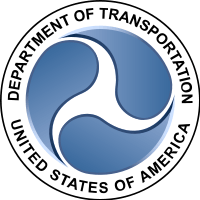Bureau of Transportation Statistics
The Bureau of Transportation Statistics (BTS), as part of the United States Department of Transportation, compiles, analyzes, and makes accessible information on the nation's transportation systems; collects information on intermodal transportation and other areas as needed; and improves the quality and effectiveness of DOT's statistical programs through research, development of guidelines, and promotion of improvements in data acquisition and use. BTS is part of RITA and is a principal agency of the U.S. Federal Statistical System.
History
BTS was created in 1992 under the Intermodal Surface Transportation Efficiency Act.[1] Since 1998 when the Transportation Efficiency Act for the 21st Century was enacted in 1998, an external advisory council, the Advisory Council for Transportation Statistics (ACTS), has advised the BTS director on the quality and objectivity relating to BTS data and analysis. ACTS meetings are open to the public and held 2-3 times per year.[2] The Deputy Secretary of Transportation established the Committee on Transportation Statistics (CTSTAT) in January 2000 to assist in bringing together data and statistical experitise. BTS chairs the committee, but all operating administrations take part, as well as the DOT Inspector General, DOT Chief Information Officer, and the DOT Assistant Secretaries for Policy and Budget Programs.[3] On February 20, 2005 BTS became part of the Research and Innovative Technology Administration.[1]
Services
TranStats is BTS's "Intermodal Transportation Database" that includes databases and statistics for aviation, highway, maritime, rail, pipeline, pedestrians, and more. Data include financial, safety, usage, and environmental information.
One popular database included in the TranStats collection is the airline on-time performance database, which includes on-time performance of every flight, airline, and airport in the United States.
References
- 1 2 "About BTS". Bureau of Transportation Statistics. Department of Transportation. Retrieved December 3, 2015.
- ↑ Advisory Council for Transportation Statistics Archived March 1, 2010, at the Wayback Machine.
- ↑ Committee for Transportation Statistics Archived March 2, 2010, at the Wayback Machine.
